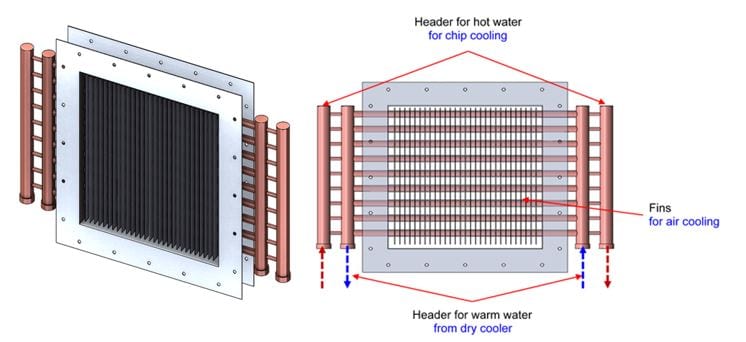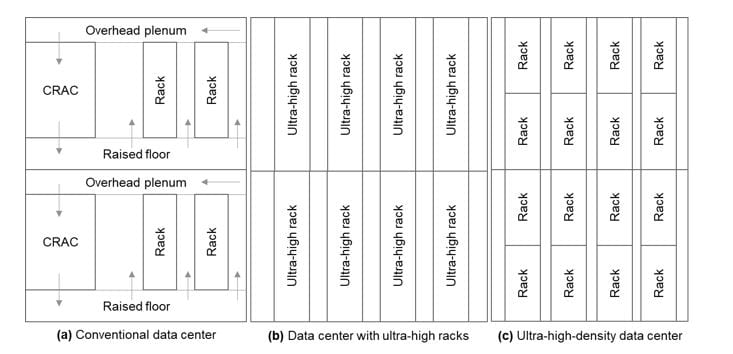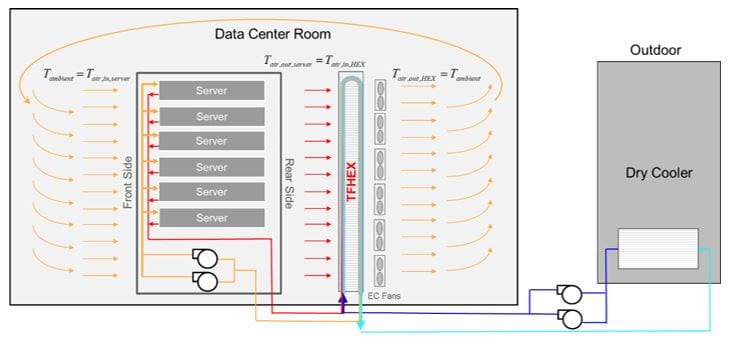Sustainable Green Data Centre
The current data centre landscape in Singapore is set to grow exponentially, especially after the opening of the China Mobile International Data Centre and of Facebook announcing their intention to set up a billion-dollar data centre locally. Furthermore, the recent declaration of joint venture between Keppel Group and Salim Group to set up a data centre in Indonesia signals a growing confidence in the data centre expertise in the ASEAN region.
Novel Oblique-fin Heat Sink
Our novel oblique fins utilise secondary flow to regenerate and disrupt thermal boundary layer. This improves fluid mixing and heat transfer rate. Based on comparative studies with the EK Supremacy EVO water block, our oblique fins sustained a reduction of temperature for about 2.5°C. In other words, oblique fin uses one-third of pumping power to achieve same bottom chip temperature. We have successfully cooled 350-400 W/cm2 high heat flux (chip-size) using the oblique-fin heat sinks.
Hybrid Cooling Solution
The oblique-fin heat sinks are employed on our hybrid cooling solution. This cooling system involves the decoupling of the cooling load in a server based on the heat flux of its components. Active electronic components will be cooled using high performance liquid/two-phase cold plates while other auxiliary components will be thermally managed by rack-level air cooling, thus supporting higher ambient temperature operations and significantly reducing energy consumption.
Triple-fluid Heat Exchanger
The novel triple-fluid heat exchanger enables highly energy efficient hybrid cooling. Heat transfer occurs between supply water from dry cooler and server coolant, as well as between supply water and rack air. The triple-fluid heat exchanger can be fitted to the rear of the rack as a rear-door heat exchanger. As such, it enables high ambient temperature operations and totally eliminate the need for chilling and is truly free cooling.
Ultra-high Density Data Centre
The ultra-high density data centre concept is achieved due to the coupling of the hybrid cooling system and the triple-fluid heat exchanger for high ambient temperature operations. Since this hybrid cooling system does not require raised floor and overhead plenum, this space can be utilised to place taller racks (e.g. 60U) depending on the floor loading and height limit. Compared to the conventional racks (e.g. 42U and 47U) which have power density up to 80 kW to 90 kW per rack respectively, the ultra-tall server rack allows the server density go much higher (e.g. 115 kW per rack). This implementation is more suitable for brownfield data centres.
For greenfield data centres, it will be possible to have shorter floor height with the removal of the overhead plenum for supply air and raised floor for return air. As a result, multi-storey data centres can now be significantly denser, i.e. more real estate is made available for accommodating additional server racks instead of wasted space for piping and ducting networks.
Schematic of Cooling System
The integration of the above components result in a data centre which is has better energy efficiency as cooling is catered for specific components on the server. System is operational in high ambient temperature, thus the need for chilling is eliminated. Removal of chiller and CRAC units leads to huge energy saving, which results in ultra-low PUE.
MTS Group and OpenPOWER Foundation
MTS Group, led by Assoc Prof P.S. Lee joined the OpenPOWER Foundation as an academic member to contribute our R&D expertise on electronics cooling and thermal solutions. With an experienced team comprising researchers, engineers and entrepreneurs, as well as nearly two decades of research practice in this area, we are confident that OpenPOWER Foundation will help us in the development of our solutions.




